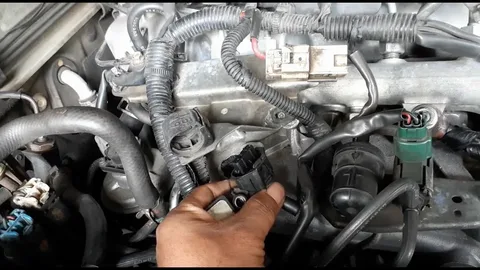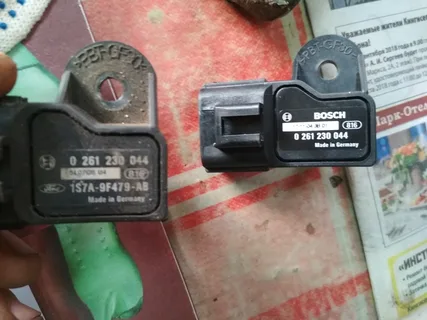The thrill of hitting the open road in your trusty Ford Ranger, feeling the rush of adrenaline as the engine roars to life, and the sense of freedom that comes with exploring the great outdoors. But, what happens when your vehicle’s performance starts to sputter, leaving you feeling frustrated and stuck in neutral? A faulty map sensor could be the culprit, secretly sabotaging your engine’s efficiency and power. The Ford Ranger Map Sensor is a critical component of your Ford Ranger’s engine management system, playing a vital role in ensuring optimal performance, fuel efficiency, and emissions control.
What is a Ford-Ranger Map Sensor and why is it important?
At the heart of your Ford Ranger’s engine management system lies a crucial component that plays a vital role in ensuring your vehicle runs smoothly and efficiently: the Map Sensor. Short for Manifold Absolute Pressure Sensor, this tiny but mighty sensor is responsible for monitoring the air pressure inside your engine’s intake manifold, providing critical data to your vehicle’s onboard computer. This information is then used to adjust fuel injection, ignition timing, and other essential engine functions, ultimately affecting your truck’s performance, fuel economy, and overall driving experience.
In essence, the Map Sensor acts as the “eyes and ears” of your engine, providing real-time feedback on the engine’s operating conditions. Without a functional Map Sensor, your Ford Ranger’s engine would be operating in the dark, struggling to make the necessary adjustments to optimize performance. This can lead to a range of issues, including poor engine performance, decreased fuel efficiency, and even engine damage. By understanding the importance of the Map Sensor and ensuring it’s functioning properly, you can unlock the full potential of your Ford Ranger, enjoying a smoother, more responsive ride and minimizing the risk of costly repairs down the road.
 Ford Ranger Map Sensor Issues
Ford Ranger Map Sensor Issues
Ford Ranger Map Sensor Issues can lead to various performance problems and drivability issues. Here are some common MAP sensor issues experienced in the Ford Ranger:
Rough Idle
A faulty MAP sensor can cause the engine to idle erratically or inconsistently. This rough idling may be accompanied by fluctuations in engine speed and uneven running.
Hesitation and Stumbling
Incorrect readings from the MAP sensor can result in hesitation or stumbling during acceleration. The engine may feel like it’s struggling to respond to throttle inputs, leading to poor acceleration performance.
Engine Surging
Surging or fluctuating engine speed, especially at steady throttle positions or during cruising, can be a sign of MAP sensor issues. The sensor’s inaccurate readings may cause the engine to surge as the ECU tries to compensate for the incorrect data.
Reduced Power and Performance
A malfunctioning MAP sensor can affect the engine’s fuel-air mixture, ignition timing, and overall performance. This may result in reduced power output, diminished engine responsiveness, and sluggish acceleration.
The impact of a malfunctioning Map Sensor on engine performance
A malfunctioning Map Sensor can have a profound impact on the performance of your Ford Ranger’s engine. When the sensor fails to provide accurate readings, the engine’s computer, also known as the Engine Control Unit (ECU), is unable to make the necessary adjustments to optimize engine performance. This can lead to a range of issues, including poor fuel economy, decreased power, and sluggish acceleration.
In severe cases, a faulty Map Sensor can even cause the engine to stall or hesitate, making it difficult to drive smoothly. Additionally, a malfunctioning Map Sensor can cause the engine to run rich, resulting in excessive fuel consumption and increased emissions. This not only affects the environment but also puts a dent in your wallet.
Furthermore, if left unchecked, a faulty Map Sensor can lead to more serious problems, such as engine damage or even complete failure. By ensuring that your Map Sensor is functioning correctly, you can avoid these issues and keep your Ford Ranger’s engine running at its best.
Benefits of Barina Camshaft Sensor
The Barina Camshaft Sensor, or any vehicle for that matter, serves several crucial functions that contribute to the overall performance, efficiency, and reliability of the engine. Here are some benefits of the camshaft sensor in a Barina:
Timing Control
The camshaft sensor provides essential data to the engine control unit (ECU) regarding the position and speed of the camshaft(s). This information is crucial for accurately controlling the timing of the engine’s intake and exhaust valve operation, ensuring optimal combustion efficiency and power output.
Fuel Injection Timing
By monitoring the camshaft position, the sensor helps the ECU determine the precise timing for fuel injection. This allows for optimal fuel delivery to the combustion chambers, promoting efficient combustion and reducing emissions.
Ignition Timing
In engines with variable valve timing (VVT) systems, the camshaft sensor plays a key role in controlling ignition timing by adjusting the position of the camshaft(s) relative to the crankshaft. This enables the engine to optimize performance and fuel economy under various operating conditions.
Engine Synchronization
The camshaft sensor helps synchronize the operation of the engine’s valves with the rotation of the crankshaft. This synchronization is critical for preventing valve timing errors, such as valve overlap, which can lead to reduced engine efficiency and performance.
Common causes of Map Sensor failure
When it comes to the Map Sensor in your Ford Ranger, failure is not uncommon. In fact, it’s a relatively common issue that can leave you stranded on the side of the road or struggling to get your truck to perform at its best. But what causes this crucial component to fail in the first place?
One of the most common causes of Map Sensor failure is contamination. Dirt, dust, and debris can easily find their way into the sensor, blocking the airflow and preventing it from reading accurately. This is especially true if you drive in harsh environments, such as construction sites or rural areas with heavy dust and dirt.
Another common cause of failure is electrical issues. Faulty wiring, corroded connections, or even a blown fuse can prevent the Map Sensor from functioning properly. Additionally, if your truck has been involved in an accident or suffered a significant impact, the sensor can be damaged or dislodged, leading to faulty readings.
Furthermore, extreme temperatures, humidity, and exposure to water can also cause the Map Sensor to fail. This is especially true if you live in an area with extreme weather conditions, such as freezing temperatures or high humidity.
Safety Features of Astra Camshaft Sensor
The Astra camshaft sensor primarily serves engine management functions rather than direct safety features. However, indirectly, it contributes to safety in several ways:
Engine Performance
The camshaft sensor ensures optimal engine performance by precisely timing the opening and closing of the engine’s intake and exhaust valves. A well-functioning engine translates to smoother acceleration, consistent power delivery, and improved responsiveness, all of which contribute to safer driving conditions.
Emissions Control
The camshaft sensor plays a role in optimizing engine combustion, which helps reduce harmful emissions. By ensuring efficient fuel combustion, the sensor indirectly contributes to lower levels of pollutants emitted by the vehicle, promoting cleaner air and a healthier environment for both drivers and pedestrians.
Fault Detection and Diagnostic Capability
Modern vehicles, including the Astra, utilize sensors like the camshaft sensor to monitor engine parameters and detect abnormalities. If the sensor detects a fault or deviation from expected engine performance, it can trigger warning lights on the dashboard, such as the check engine light. Prompt attention to these warnings can help drivers address potential issues before they escalate into safety hazards.
Replacement vs. Repair: What’s the best option?
When it comes to dealing with a faulty Ford-Ranger map sensor, you’re faced with a critical decision: should you replace it or try to repair it? While it may be tempting to try to salvage the existing sensor, the reality is that repair is often not a viable option. Map sensors are intricate devices that rely on precise calibration and delicate internal components to function correctly. If your sensor is malfunctioning, it’s likely that the damage is too extensive to warrant repair.
In contrast, replacing the map sensor with a new one can be a relatively straightforward process, especially if you’re comfortable with basic DIY mechanics. Not only will a new sensor ensure accurate fuel injector timing and optimal engine performance, but it will also eliminate the risk of further damage to your engine and other components. Additionally, a replacement sensor is likely to come with a warranty, providing peace of mind and protection against future failures. By opting for a replacement, you’ll be able to get back on the road quickly and confidently, with your Ford Ranger running at its best.
Conclusion
The Ford Ranger Map Sensor is often overlooked, but its significance in the grand scheme of your Ford Ranger’s performance cannot be overstated. This tiny yet mighty component plays a pivotal role in ensuring your engine is running at its best, providing the perfect air-fuel mixture, and optimizing power output. A malfunctioning Map Sensor can lead to a plethora of issues, from decreased fuel efficiency and reduced power to poor engine performance and even damage to other critical components. By understanding the importance of a functional Map Sensor, you can take proactive steps to maintain your vehicle’s health and performance.
FAQs
What does the Ford Ranger Map Sensor do in my Ford Ranger?
The Ford Ranger Map Sensor measures the pressure within the intake manifold of the engine. This data is used by the engine control unit (ECU) to calculate air density and adjust fuel injection and ignition timing accordingly. In essence, the MAP sensor helps optimize engine performance and fuel efficiency.
How can I tell if my Ford Ranger’s MAP sensor is faulty?
Common symptoms of a faulty MAP sensor in the Ford Ranger include rough idling, hesitation or stumbling during acceleration, engine surging, and illuminated check engine light (CEL) with related diagnostic trouble codes (DTCs) such as P0105 (MAP/BARO circuit malfunction) or P0106 (MAP sensor range/performance problem). If you experience any of these symptoms, it’s advisable to have the MAP sensor inspected and tested by a qualified mechanic.
Can a dirty MAP sensor cause problems in my Ford Ranger?
Yes, a dirty or contaminated MAP sensor can lead to inaccurate readings and affect engine performance. Dirt, oil residue, or carbon buildup on the sensor’s sensing element can hinder its ability to accurately measure manifold pressure, resulting in poor fuel economy, reduced power, and emissions issues. Regular cleaning and maintenance of the MAP sensor can help prevent such problems.
How do I clean the MAP sensor in my Ford Ranger?
Cleaning the MAP sensor in the Ford Ranger involves removing it from the intake manifold and using an appropriate electronic parts cleaner or solvent to gently remove any dirt or debris. Be careful not to damage the delicate sensing element. Once cleaned, allow the sensor to air dry thoroughly before reinstalling it. It’s essential to consult the vehicle’s service manual for specific cleaning procedures and safety precautions.
| Other Good Articles to Read |
| skank blogs |
| unreal blogs |
| tba blogs |
| all city forums |
| dany blogs |
| refuge blogs |
| the music blogs |
| key forums |
| the big blog theory |
| joe blogs |
| blogs 4 me |
| Blogs Emon |
| Related Business Listings |
| Contact Directory |
| Local Business Profiles |



